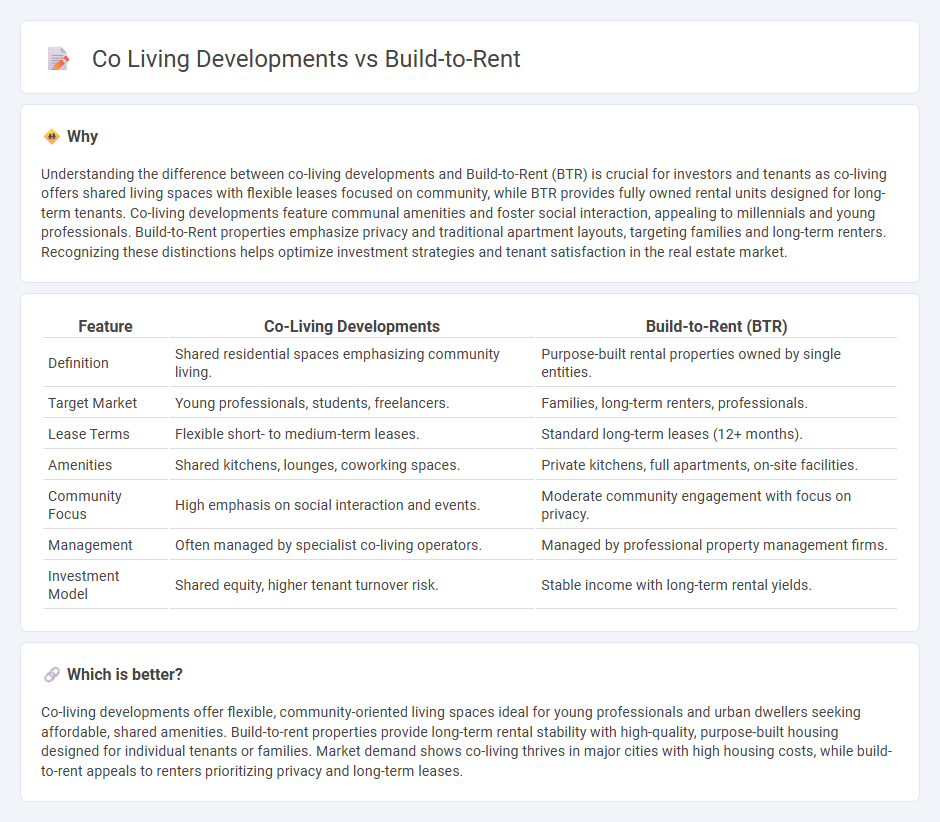
Co-living developments emphasize shared living spaces and community amenities tailored for urban dwellers seeking affordability and social engagement. Build-to-Rent properties focus on professionally managed rental units designed for long-term tenants, offering privacy and consistent maintenance services. Explore the distinct benefits and investment potentials of co-living versus build-to-rent models in modern real estate.
Why it is important
Understanding the difference between co-living developments and Build-to-Rent (BTR) is crucial for investors and tenants as co-living offers shared living spaces with flexible leases focused on community, while BTR provides fully owned rental units designed for long-term tenants. Co-living developments feature communal amenities and foster social interaction, appealing to millennials and young professionals. Build-to-Rent properties emphasize privacy and traditional apartment layouts, targeting families and long-term renters. Recognizing these distinctions helps optimize investment strategies and tenant satisfaction in the real estate market.
Comparison Table
| Feature | Co-Living Developments | Build-to-Rent (BTR) |
|---|---|---|
| Definition | Shared residential spaces emphasizing community living. | Purpose-built rental properties owned by single entities. |
| Target Market | Young professionals, students, freelancers. | Families, long-term renters, professionals. |
| Lease Terms | Flexible short- to medium-term leases. | Standard long-term leases (12+ months). |
| Amenities | Shared kitchens, lounges, coworking spaces. | Private kitchens, full apartments, on-site facilities. |
| Community Focus | High emphasis on social interaction and events. | Moderate community engagement with focus on privacy. |
| Management | Often managed by specialist co-living operators. | Managed by professional property management firms. |
| Investment Model | Shared equity, higher tenant turnover risk. | Stable income with long-term rental yields. |
Which is better?
Co-living developments offer flexible, community-oriented living spaces ideal for young professionals and urban dwellers seeking affordable, shared amenities. Build-to-rent properties provide long-term rental stability with high-quality, purpose-built housing designed for individual tenants or families. Market demand shows co-living thrives in major cities with high housing costs, while build-to-rent appeals to renters prioritizing privacy and long-term leases.
Connection
Co-living developments and Build-to-Rent (BTR) properties share a focus on creating community-centric living environments that cater to urban renters seeking flexibility and social interaction. Both models emphasize high-quality amenities, managed services, and long-term leasing options, appealing to millennials and young professionals. Real estate investors are increasingly integrating co-living concepts within BTR projects to maximize occupancy rates and enhance tenant retention through shared spaces and collaborative lifestyles.
Key Terms
Ownership Structure
Build-to-Rent developments are typically owned and managed by institutional investors or real estate investment trusts (REITs), ensuring long-term asset control and consistent property management. Co-living developments often feature a mix of ownership structures, including private developers, venture capital firms, and sometimes community ownership models, prioritizing shared space and social experiences. Explore further insights into how ownership impacts tenant experience and investment strategies in these residential models.
Lease Agreement
Build-to-Rent developments typically feature long-term lease agreements that offer tenants stability and fixed rental terms, appealing to families and professionals seeking permanence. Co-living developments, in contrast, often utilize short-term, flexible lease agreements designed to accommodate transient residents and foster community engagement. Explore the key differences in lease negotiations and tenant rights in these models to find the best living arrangement for your needs.
Amenities Package
Build-to-Rent developments typically offer private, high-quality amenities such as fitness centers, rooftop lounges, and secure parking tailored to long-term tenants seeking exclusivity and personalization. Co-living developments emphasize shared communal spaces like co-working areas, social kitchens, and group lounges designed to foster community interaction and affordability among residents. Explore detailed comparisons of amenity packages to determine which housing model best suits your lifestyle preferences.
Source and External Links
A.CRE Build-to-Rent (BTR) Development Model (Updated May 2025) - Build-to-Rent (BTR) is a real estate sector focused on developing whole neighborhoods of attached and detached homes for long-term rental, owned and managed by a single entity, with community amenities and professional management tailored to renters seeking flexibility and privacy.
What You Need to Know About 'Build to Rent' (BTR) - CrowdStreet - BTR represents an evolution of single-family rental (SFR) housing, offering professionally managed, amenity-rich residential neighborhoods designed specifically for renters, with benefits such as community features and no HOA fees.
Build-to-Rent Residential Market Overview - CBRE - BTR homes are professionally managed, high-quality single-family or townhomes that emphasize privacy, durable construction, exclusive outdoor space, and community amenities like parks and swimming pools, situated in transit-oriented, low-density neighborhoods appealing particularly to families and empty nesters.
 dowidth.com
dowidth.com